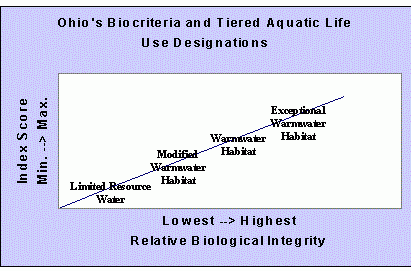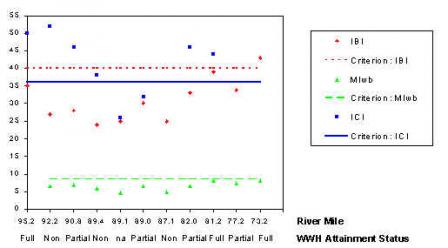Ohio's Tiered Aquatic Life Use Designations Turn 20 Years Old
Water quality standards consist of designated uses and the chemical, physical, and biological criteria designed to represent measurable properties of the environment that are consistent with the goals specified by each use. Prior to 1978, Ohio's water quality standards specified only one general aquatic life use for all waters of the state. In 1978, the standards were revised in an attempt to recognize the variability inherent in natural aquatic ecosystems by having a tiered classification scheme for different aquatic life uses. Although the classifications were based upon ecological attributes, the criteria associated with them at the time were entirely chemical and physical. This changed by 1980, when the early narrative biological criteria were developed. These narrative biocriteria, derived from the tiered use designations, were in turn the forerunners of the current system of numeric biocriteria.
The tiered system of use designations provides for different levels of protection and reflects the choices implicit in reconciling the "ideal" (represented by least impacted reference conditions) with the "reality" the ongoing effects of two centuries of intensive human use of the state's land and water resources.
The aquatic life use designations are assigned to individual waterbody segments based upon the potential to support that use according to narrative and numerical criteria. Observing actual attainment of the criteria in order to designate a particular use is not necessary; if this were the case, there would be little incentive to improve degraded aquatic systems. The Warmwater Habitat (WWH) is applicable to most of the state's rivers and streams. The Exceptional Warmwater Habitat (EWH) is used for waters with unique and unusual assemblages of aquatic life (e.g., waters with the potential for significant populations of endangered species, unusually good chemical quality, above-average abundance of sensitive species, above-average populations of top carnivores). The Modified Warmwater Habitat (MWH) applies to extensively modified habitats that are capable of supporting the semblance of a warmwater biological community, but fall short of attaining WWH because of functional and structural deficiencies due primarily to altered macrohabitat. The lowest degree of biological integrity, reflecting poor and very poor communities, is Limited Resource Water (LRW).

The use designations contain a narrative goal statement, as well as the index thresholds for the numerical biocriteria. Ohio's biocriteria include two indices based on stream fish assemblages (Index of Biotic Integrity, IBI, and the Modified Index of Well-Being, MIwb) and one index based on stream macroinvertebrate assemblages (Invertebrate Community Index, ICI). Biocriteria were developed based on the data collected at reference sites, and further distinguished by type of site (headwaters, wading or boat) for the fish indices. To account for regional landscape variability, the reference sites were established for each of Ohio's five ecoregions: Huron-Lake Erie Plain, Eastern-Ontario Lake Plain, Eastern Corn Belt Plain, Western Allegheny Plateau, and Interior Plateau. Ecoregional stream systems are defined primarily by local conditions of climate, geology, soils topography, terrestrial vegetation, and land use.
The numeric biocriteria for the WWH designation specify a value at the 25th percentile of the reference site scores. Thus the biocriteria for a stream segment designated WWH will vary according to the reference site results for that type of site within that ecoregion. The EWH biocriteria are based on a combination of the entire statewide reference site data (by organism group and site type) at the 75th percentile value. As an example, the biocriteria for WWH and EWH for one of Ohio's ecoregions, the Erie/Ontario Lake Plain, are listed below.
| Index-Site Type | WWH | EWH |
|---|---|---|
| IBI-Headwaters/Wading | 40 | 50 |
| IBI-Boat | 40 | 48 |
| MIwb-Wading | 7.9 | 9.4 |
| MIwb-Boat | 8.7 | 9.7 |
| ICI | 34 | 46 |
The results of biosurveys that are conducted on the state's streams and rivers are organized in use attainment tables. A use attainment table includes: the sampling location for fish and macro-invertebrates by river mile (upstream to downstream); the resulting scores for the fish assemblages (IBI and MIwb) and macro-invertebrate assemblages (ICI); the score for the assessment of physical habitat (Qualitative Habitat Evaluation Index , QHEI); the use attainment status (full, partial or nonattainment); and any pertinent comments with regard to the proximity of the site to pollution sources and other impacts.
The aquatic life use attainment status for the Hocking River in 1990 is presented in the figure below, which illustrates part of the information contained in the use attainment table. The values for each index (IBI, MIwb, and ICI) are indicated by the data points for each sampling location. The horizontal lines indicate the biocriteria values specific to the ecoregions involved (Erie/Lake Ontario Plain in upstream segments and Western Allegheny Plateau in downstream segments). The use attainment status (full, partial, or nonattainment) for each sampling location is also given.
Aquatic Life Use Attainment Status for the WWH Use Designation in the Hocking River, 1990

To determine the use attainment status at each sampling location, the following guidelines are used:
- FULL A use is considered to be fully attained when all of the biological indices meet the biocriteria value for the applicable use designation, ecoregion, and site type. Values that are within the nonsignificant departure range (4 IBI or ICI units; 0.5 Miwb units) are considered to meet the biocriteria. Thus, in the Hocking River example, the WWH use is considered to be fully attained at river miles 81.2 and 73.2, even though the value for the MIwb is 8.1, which is slightly below the applicable criterion of 8.6.
- PARTIAL A use is considered to be partially attained if one or two biological indices indicate attainment, but others do not; for the EWH and WWH use designations, the biological indices that fail to meet the applicable biocriteria must at least be within the fair range of performance.
- NONATTAINMENT A use is not attained if all of the biological indices fail to meet the biocriteria, or if either organism group reflects poor or very poor performance, even if the other organism group meets the biocriteria.
This system is thus defined and structured while allowing for necessary flexibility and professional judgment. For example, ecoregion boundaries cannot be determined merely from the boundaries on a map, as there is a gradation between ecoregions. Similarly, the results at any one site must be interpreted in the context of the results obtained at the surrounding sampling sites to get an overall picture of the health of the aquatic ecosystem.
The standardized classification hierarchy that Ohio EPA has used for the past 20 years has allowed the agency to set measurable goals for specific surface waterbodies. The tiered aquatic life use designations and supporting biocriteria provide a structured, quantitative framework for assessing biological integrity as opposed to vague and arbitrary pronouncements that may depend on the particular individual making the judgement. In fact, the biocriteria procedures have withstood close scrutiny in the Ohio court system during legal challenges to the upgrading of stream segments from LWH to WWH.
Lesson Learned
In Ohio, biological data and definition of regional reference conditions have led to a stratification of expectations for streams and rivers. This is turn has led to a more refined application of chemical criteria and antidegradation procedures, and has provided a firmer basis for regulatory decisions concerning habitat manipulation and nonpoint sources.
Additional Information
Contact: Chris Yoder (yoderc@ohio.edu) at 614-728-3382
References
Yoder, C.O., and E.T. Rankin, 1995. The role of biological criteria in water quality monitoring, assessment and regulation. Ohio EPA Technical Report MAS/1995-1-3.
Yoder, C.O., and E.T. Rankin, 1995. Biological criteria program development and implementation in Ohio, pp. 109-144 (Chapter 9). In W.S. Davis and T. Simon (eds.). Biological Assessment and Criteria: Tools for Water Resource Planning and Decision Making. Lewis Publishers, Boca Raton, FL.
